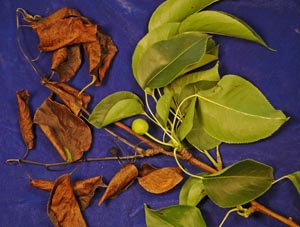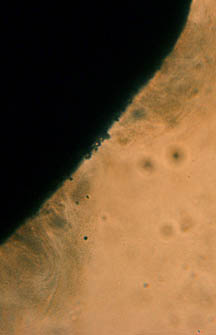Fire Blight Is Here | |
|---|---|
| June 9, 2008 | |
|
In issue no. 2 of this newsletter, I wrote about fire blight and predicted we would be seeing many cases in the coming weeksóbecause the pathogen, Erwinia amylovora, infects blossoms in wet weather with the optimal temperature range of 65? to 86?F. You can understand that it was not difficult to predict that the disease would be a problem this season. The image shows typical smptoms of fire blight on pear, a sample that was recently received at the Plant Clinic.  The symptoms are dramatic, for example, black stems with black leaves, leaving no question that tissue is dead. Infected tissue on pear turns black. On apple trees, the infected tissue turns brown. Other than ornamental pear, most ornamental species turn brown when infected with fire blight. Look for water-soaked or wilted new growth that quickly turns brown to black and remains attached to the stem, as in the image. The symptoms are dramatic, for example, black stems with black leaves, leaving no question that tissue is dead. Infected tissue on pear turns black. On apple trees, the infected tissue turns brown. Other than ornamental pear, most ornamental species turn brown when infected with fire blight. Look for water-soaked or wilted new growth that quickly turns brown to black and remains attached to the stem, as in the image. Look-alike problems include frost injury, heat stress (for example, fire under the tree, blacktop application under the tree), chemical damage, and possibly Psuedo-monas blast, a condition that occurs in near-freezing weather. In the lab, we can confirm the presence of fire blight by observing bacterial streaming with a microscope. The image shows a section of infected petiole (black area on left) exuding thousands of bacterial cells (granular mass to the right).  That tissue is cultured in the lab and bacterial isolates confirmed as Erwinia species. That tissue is cultured in the lab and bacterial isolates confirmed as Erwinia species.Because the bacterium originates on old cankers and bark infection, removal of branches killed by fire blight is extremely helpful in disease control. This should be done when the tree is dormant or when weather is hot and dry. Do not remove infected wood in the spring. Disinfecting pruning equipment is an important step in reducing disease spread. Use 10% household bleach or similar disinfectant between cuts. Cut out infected branches, going 6 to 8 inches into the good wood to be certain all infected tissue is removed. Refer to issue no. 2 of this newsletter for details on possible chemical applications. There will be little benefit from sprays this late in the season. One exception would be spraying an infected tree immediately after a storm. Succulent, wounded tissues may be infected with the fire blight bacterium. | |
| Author: | Nancy Pataky |
